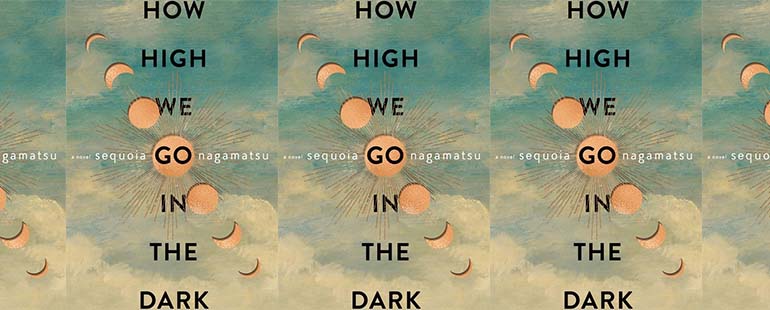Mundanity Among Tragedy in How High We Go in the Dark

Told from the perspectives of a handful of narrators across time and space, Sequoia Nagamatsu’s debut novel, How High We Go in the Dark, out this week, layers tragedy on the mundane struggles of human existence when an ancient virus is reactivated by the Arctic’s melting permafrost, sparking a multi-year pandemic in 2031. Published two years into the COVID-19 pandemic, How High We Go in the Dark is in some ways comforting: Look at how things could have played out, but haven’t, it says. The novel’s virus, dubbed the “shape-shifter syndrome,” initially impacts mostly children, though it later spreads to adults and those who fall ill glow as if stars pulse through their veins. The virus also, less enchantingly, morphs organ tissue so that a liver may be overtaken by lung tissue or brain cells swapped for a heart’s. Refrigerator trucks and ice hockey rinks are not enough for this pandemic’s body count. Death takes over the landscape. In Japan, “dark monolithic towers punctuated by clouds and 3-D billboards remind . . . the city that we’ll all die one day and we should take advantage of their mortuary package specials.” In the Bay Area, “tech campuses [are] temporarily transformed into funerary processing centers and overflow clinics for the plague drug trials . . . A line wraps around the old offices of a dating app.” But in other ways, How High We Go in the Dark reflects exactly the moment we’re living in. Through the course of the tragedies and mundanities explored within, every facet of every person’s life is altered, and Nagamatsu depicts how people handle a changing world.
Clara, the daughter of the book’s first narrator, Dr. Cliff Miyashiro, is obsessed with the ways the world is changing and frustrated by people’s seeming disinterest in what’s happening around them. As a kid, she began keeping color-coded journals chronicling disasters like school shootings and collapsing ice shelves and later became a researcher studying climate change. It’s Clara who discovers Annie, the Neanderthal girl in whom the virus is first discovered. After Clara dies in an accident, Cliff replaces her on the research team, and as the virus begins to explode, he writes to Clara, “You had a vision of what life would be like for future generations and acted like the planet had a gun to our head. And maybe it does.” In the book’s following sections, the gun goes off again and again. One narrator observes of the devastation, “Rising sea levels, California burned to a crisp every year, plague wards filled with patients . . . yeah, it’s a party down here.” In Japan, cities are surrounded by sea walls that must grow taller and taller as the sea level rises.
In the midst of these environmental changes, people must also reconsider the choices they make to handle the rapidly increasing body count. In the early years of the plague, the government opens euthanasia parks, including one called the City of Laughter, where parents take their sick children to die after one last day of fun. The final ride is the Chariot of Osiris, a ride that painlessly puts children to sleep. Elegy hotels (which already exist in real-life Japan), hotels for the living to be with the dead just a little longer before they are cremated, become popular. There are also “[c]ryogenic suspension companies . . . death hotels, services that preserved and posed your loved ones in fun positions, travel companies that promised a ‘natural’ getaway with your recently departed.” The desire for creative solutions to processing bodies continues after the pandemic ends, when other diseases fell those who are cured of the virus. One narrator says, “My company provides artistic alternatives to burial and cremation, one of the many ‘new death’ companies that became popular after the plague, as people died from the chronic illnesses that remained in their bodies.” His client refers to the company’s “state-of-the art resomation chamber . . . [as] a human Crockpot.” The employee works with his client to create an ice sculpture vessel for the client’s ashes to sail out to sea in. There are funerary banks, funerary mortgage companies, funerary corporations—all groups that leech off the pandemic’s high body count. Money can buy more, and debatably better, means of remembering the dead. Death must be done just right, society believes—or at least to the extent that one can afford with some loans.
The diversification in funerary services results in a booming funerary industry in the global capitalist market. Lucrative funeral companies prey on the billions of people needing their services, but they must also reinvent themselves to maintain a competitive edge. When a man and his son go to visit the ashes of Ayano, their wife and mother, respectively, the pervasiveness of the funeral industry colors their entire trip. Ayano’s ashes are stored in a high-rise columbarium outside of Tokyo in urn #25679B. On the train there, they pass “Yamamoto Funerary Mall. Stop here for incense, flowers, and gift stores [and] Yamamoto Funerary Food Square. Stop here for ATMs, hotels, and the City Mortuary Affairs Office.” When they arrive, “[t]he monitors above [their] heads advertise catering services, a company that can send a rocket filled with your loved one’s ashes into space, premier packages for holograms of the departed that can be projected from a stainless steel urn.” While they are with Ayano’s urn—having paid “two thousand yen for an hour of suite time”—a “banner ad on the wall tells [them] to cherish Ayano’s memory by enjoying life via a buffet at the food court in tower 2.” As they seek comfort by visiting her, the narrator and his son are continuously bombarded with more and more ways to spend money “honoring” the dead. The advertising is aggressive, yet for the narrator and his son as well as those around them the ads have become a part of life. Nagamatsu underscores our desire to hold on to those we love no matter the cost and how the plague only accelerates humans’ exploitative nature as well as our ability to become desensitized to it.
Just as people struggle with what to do with their dead in How High We Go in the Dark, so too must they figure out how to live their lives. When people stricken by the virus fall into a coma, they wake in another realm surrounded by darkness and jellyfish-like globes that display their memories. Though their physical bodies are inaccessible, “[p]eople still [express the] need to pick up their children, feed their dog, say I love you to their spouses. For now, no one has brought up the fact that in the real world, [their] bodies are inhabited by an impossible virus.” It is unclear whether they will ever regain consciousness, yet they are drawn, desperately, to their daily tasks and the regularity of being part of the world. “I wonder if this is it,” a narrator, Jun, says, “perpetual bickering, wallowing, or if, perhaps one day (whatever time counts for here), we’ll find another way to occupy the dark, figure out how to fill it with all that we were and all that we know, now that we’ve been separated from the slog of life.”
For Jun, these mundanities are not comforting. He’s upset to be sick and to have seen the pained look on his parents’ faces before he fell into a coma, and he indicates that existing in this dark realm necessitates change. Similarly, when Miki and her granddaughter, Yumi, Clara’s mother and daughter, set off on a space expedition to find a new planet to call home half a decade after the plague begins, Miki wonders, “How do you say goodbye when you know you’ll be alive hundreds if not thousands of years after everyone you’ve ever known has died?” Miki has lost her daughter and husband and is about to part ways with her planet. On the journey, she learns how to make a new life. Great change requires a rethinking of everything.
Back on earth, the plague’s cure hasn’t cured the people of living with the plague. “People like to forget about the sadness of the city,” a woman whose daughter has been permanently disabled by the virus says. “They walk and walk. No one stops. It’s like we’re all still infected. We choose to be blind to each other’s suffering. It might make things easier to bear, but our hearts are cold.” In one way or another, the plague has infected everyone.
How High We Go in the Dark thus asks what it means to be human. Nagamatsu considers how change shapes generations, what love and xenophobia look like in pandemic, what we actually lose when we lose family and research subjects and the planet. How we react, he seems to argue, determines what we’re left with. “All I do know is this,” reflects Dan Paul, a man reacquainting himself with his neighborhood after life has begun to return to normal, “I will continue to wake up and tell my family that I love them, something I never did enough when they were alive. I will go grocery shopping at midnight. I will tell strangers online that I’m sorry for their loss, and I will eventually wash the bedsheets and their clothes and be okay with a quiet home. Maybe, with help, I will wave at you when you cross the street. I will begin setting the table for one.” This is it, Dan says, there’s nothing left but to move forward with the world as it is. You may not have gotten to say goodbye, but you can’t linger in regrets. As Cliff told Clara, “you only have one life,” one you still have to live despite the absence around you. Settle into the new landscape.



